Circular 25/1986: Licensing of Taxis and Private Hire Cars
A Circular providing information for local licensing authorities on the licensing of taxis and private hire cars and their drivers. This is not a stand alone document and must be read in conjunction with 'Taxi and Private Hire Car Licensing: Best Practice for Licensing Authorities'
ANNEX C
FARES SCHEMES FOR SHARING TAXIS
General
1. There are four basic ways in which shared fares might be charged by taxi drivers, though all four are susceptible to, extensive variation. The four methods are:
a. a flat-fare system;
b. a zone system;
c. modified use of existing meters;
d. use of special (or specially adapted) meters.
Before describing these various methods, however, two points should be made about shared-fare scales in general.
2. Any scheme for shared fares should offer an incentive both to the taxi operator and to the intending passengers. That is, the aim should be that the operator should take in more than he would have for an exclusive hire, and that each passenger should pay less. However, care has to be taken in setting the level of both incentives. If the extra which the operator will take on a shared hire is set too high, passengers will not make use of the service. In particular, most authorities will want to make it a condition of an operator's licence that the first hirer should always have the right to insist on exclusive hire even if the operator is offering sharing. It follows that if a group of passengers board together at the beginning of a hire they could always decide on an exclusive hire and so - because of the existence of the operator's premium always get a cheaper journey by making their own arrangements for sharing the exclusive fare. Even in such circumstances, it seems likely that many passengers will be content to pay a little more than they would have paid by sharing an exclusive hire in order to have the benefit of having the driver find other passengers to share (say, from a queue for taxis); and of not having to negotiate with the other passengers once they are found, but being able to pay the driver direct. But there will be a limit to what they are prepared to pay for these conveniences, and if the premium for the taxi operator is set too high it will probably not take passengers who are all boarding together very long to realise how much they could save by stipulating an exclusive hire, so that the setting of too high a margin for the operator will become self-defeating. Similarly, if the margin for the operator is set too low, there will be no reason for him to take the trouble of collecting separate fares, finding passengers to share, stopping to pick up additional passengers (in a full sharing system), and of dealing with the inevitable - even if only occasional - dispute, at least until the travelling public has become used to the system; about who is liable to pay what. How these margins for passengers and operator should be set will be a matter for the judgement of the licensing authority; but if they are not pitched at the right level then both the taxi trade and their passengers will be denied the benefits of a properly operating system for shared fares.
3. A second general point is that any shared-fare system should be readily understandable by both passenger and driver. Ideally, there should be a meter display for each passenger. If this is not feasible when sharing schemes are first introduced, then the fare to be paid by each passenger should at least be easily calculable by both driver and passenger: the fares scheme should not depend on the performance of complicated arithmetic on the fare shown on the meter (although of course it is always possible for the licensing authority to issue tables relating the fare to be paid by each of a particular number of sharing passengers directly to the sum shown on the meter). In many situations, a fares scheme which does not depend on metering at all may be very much preferable for both driver and passenger, but any temptation to make the scheme more complicated than absolutely necessary should obviously be resisted.
Flat-fare systems
4. These systems will be particularly applicable where the variation from the average in the length of the journey made by each passenger is insignificant compared with the average, taken over a reasonably large number of passengers. "Insignificant" is obviously a matter for definition; but it might be reasonable to say that a variation is insignificant if it is less than, say, 20% of the average. An obvious example would be airport taxis: all the passengers would be coming from (or going to) the airport at one end of the journey; and overwhelmingly the other end of their journey will be close to the town centre. So, for example, if the distance from the airport to the town centre is 5 miles, by far most of the passengers will be going 5 miles, give or take a few hundred yards. If the likely variation in journey length, at the extremes, is between 4 and 6 miles, then the variation from the average is 1 mile, which is exactly 20% of the average. (If a licensing authority feels it to be advisable it would be possible for it to specify a central zone within or before which an airport taxi may set down, and within or after which it may pick up, though care should be taken as always, to avoid excessive complexity in the system.) Another example where a flat-fare system, might be appropriate would be where a common taxi journey is from a closely clustered group of small towns and villages into a neighbouring city centre (and back); but licensing authorities will be best placed to identify for their own areas trips for which a flat charge would be both workable and appropriate.
5. It should perhaps be made clear that a flat-fare system does not mean that the fare should be like a bus fare, not dependent on the number of passengers travelling. The general remarks about incentives at paragraph 2 apply, so that the more passengers who were sharing the taxi at any time during the journey, the less each passenger would pay; and the amount paid would be the same for each, irrespective of how far any of the passengers actually travels.
Zone systems
6. A slightly more complex system is the zone system. In this system, the licensing authority divides the designated area into zones. These need not by any means be of the same size, but it is highly desirable in the interests of comprehensibility that there should not be too many zones and that the boundaries between zones should follow easily recognisable features such as main arterial routes, railway lines, rivers and so on. Every passenger pays a hiring charge plus an additional charge - which for greatest simplicity, can be the same as the hiring charge - for every different zone which the taxi necessarily enters during his or her journey .(thus, the fare is not inflated by zig-zagging across a zone boundary). The hiring charge and the zone charge can be made to depend on the greatest number of passengers during any part of an individual passenger's journey, and indeed different zone charges can be specified for different zones; but in order to avoid complicated record-keeping and to reduce the scope for argument, it is highly desirable that there should be only two scales, one for exclusive hire and one for shared hire and that the charge for each zone should be the same. Zone systems are likely to be most suitable in small towns, or in areas where the choice of route is not too great.
Metered systems - modified use of existing meters
7. For greatest comprehensibility and least scope for disputes the use of a meter will-usually be best. Not only are most taxis already equipped with sophisticated meters, but public confidence is sustained by having some guarantee that passengers are not being overcharged. There are available on the market meters which are capable of computing shared fares where passengers both board and alight at different points; and it seems likely that such meters will eventually become the standard for most taxis in Scotland. However, time has to be allowed for the public to become used to shared taxis; then for the trade to test whether and when offering such a scheme is likely to be worthwhile commercially then, finally for meter manufacturers to be persuaded that there is a large enough potential market amongst taxi operators for it to be worth the commercial risk of developing a meter sufficiently versatile to meet the stipulated requirements. During this lead time, it may not be practicable for all authorities to lay down shared taxi fare scales which depend for their operation on a type of meter in comparatively short supply. Existing meters could be used to determine shared fares, in a rough and ready way where all the passengers board more or less at the same place (and get off at quite different places); but there is no simple way of using them for a full sharing system that is one with both boarding and alighting at different points. Thus, in the initial period, authorities may wish to require by means of a licence condition that, where a meter is used at all (that is, apart from flat-fare or zone systems), all the passengers should start the journey within a specified distance of each other - say before the meter has registered its first increment after the starting charge for the first hirer. However, it must be emphasised that this would genuinely be an interim dispensation. The Government's clear objective is that, in Scotland with its less centrally regulated taxi system, full sharing systems should be introduced as widely and as quickly as possible. It is therefore to be expected that, after allowing a suitable lead time and thereafter giving due notice, the Government would if it proves necessary introduce regulations under section 20(1) of the Civic Government (Scotland) Act 1982 to prohibit licensing conditions whose effect is to limit sharing to the case where all the passengers board more or less together.
8. If, for the moment, fixed charges such as the initial hiring charge, waiting time and "extras" are put to one side, the shared fare should depend only on the extent to which the taxi has been shared and the distance that each passenger has been carried. As a rule, most of the passengers on a shared hire will have been carried for a greater distance than they would have been on an exclusive hire; but there is no way of allowing explicitly for these diversions made to set down other passengers, even with the most sophisticated meters. They will therefore have to be allowed for, obviously only approximately, in setting the shared fare tariff (that is, no passenger should be at all likely, because of diversions on a shared hire, to pay anything approaching what would have been the exclusive fare).
9. In the case, first, where all the sharing passengers board more or less together, it would be possible to provide that each passenger should pay a stipulated proportion of the fare shown on the meter when he or she leaves the taxi. This stipulated proportion could:
a. be the same for all passengers and not depend on how many passengers (provided of course that there were at least two of them) were sharing at the outset;
b. be the same for all passengers, but depend on how many passengers were sharing at the outset, being lower the more passengers there were;
c. be different for each passenger, depending on the order of alighting (with the last passenger to leave paying the largest proportion, and passengers alighting earlier paying a progressively smaller proportion).
10. All these schemes suffer from drawbacks. In general there is the difficulty of arguments over the arithmetic, even if the percentages are kept simple; and as the scheme becomes more complex, so does the scope for argument. Scheme (a), first, does not reflect the extent of the sharing; and so offers no incentive for two passengers to look for any more to share with them; and so reduces the value of the sharing system. Second, the return to the driver shows an enormous variation. Third, the driver would stand to lose money where the last passenger left in the taxi gets off much after the others, and so enjoys a long ride at the discounted rate although he or she will have bad exclusive use of the taxi for most of the journey. Scheme (b) does recognise the extent of the sharing (at the cost of more complication) and does reduce (but by no means eliminate) a large variation in the return to the driver; but the third objection remains - the driver could lose money compared with an exclusive hire if the last passenger or passengers travelled a very long way compared with the first. Scheme (c) greatly reduces this last effect: the difference between the longest and the shortest rides would have to be very great for the driver to lose on the deal though the risk is not eliminated entirely (in fact, no scheme of this sort could do so). But scheme (c) is also much the most complicated; and there is scope not only for argument but for struggling as one passenger tries to leave before another who is going more or less the same distance. The conclusion must be that schemes of this sort (and variations whereby each passenger pays a fixed sum in addition to the stipulated percentage of the fare shown on the meter) would work only where it could be guaranteed, by one means or another, that the variation in the journey lengths could not be sufficiently great to cause the driver a relative loss, while not being sufficiently small to justify a flat-fare system. In other circumstances this kind of scheme cannot be recommended.
Special meters
12. There is no question but that special meters for sharing (also able to handle exclusive hires) would be best. Such meters must at least
a. be capable of running at more than one tariff - ideally, up to five tariffs to cater for the maximum number of passengers allowed in some licensing areas.
For a full sharing system, they must also
b. be capable of storing in separate memories the fare so far for each passenger (and incrementing it in accordance with the fares scheme in operation), and perhaps of displaying them simultaneously or in rotation.
Finally, the ideal meter would also
c. be able to store and display fixed charges for each passenger.
The last, however, is not essential and may in fact be undesirable in the interests of simplicity.
13. It is understood that most modern meters are already of type (a): they can hold a number of different tariffs, though often only four of them. So they can be programmed (and then sealed) to run at a rate appropriate to the number of people sharing:
Tariff 1 - exclusive rate
Tariff 2 - two people sharing
Tariff 3 - three people sharing
Tariff 4 - four or more people sharing
Tariff 1 would therefore be 100% of the exclusive rate, and tariffs 2, 3 and 4 would represent progressively smaller percentages (in that order) of the exclusive rate. If, for example, four people boarded a shared taxi the meter would be set at tariff 4. When the first passenger left it would be stopped (not zeroed) and he would pay the amount shown on the meter, which would then be set to run at tariff 3. This would be repeated until the last passenger remained, when the meter would be set to run at the exclusive rate. In this way, most existing meters could be used to emulate a meter for a full sharing system in the special case where all the passengers boarded together.
14. A meter for a full sharing system would, technically, be very little different from this. The only difference would be that it would have four or five incrementable memories which could be displayed on request. So, for example, the taxi might set off with one passenger: the driver would set the meter to tariff 1 (and the current tariff should be displayed on the meter so that the passenger could see that the correct tariff was being used). Some way along the route, a second passenger might be picked up. The driver would switch to tariff 2, the meter would then not only run at the discounted rate but it would also transfer the fare so far for the first passenger to memory 1 (if it has not been doing so all along); and zero the charge for passenger 2. If a third passenger joined the taxi, the meter would be switched to tariff 3, storing the fares for passengers l and 2 so far in memories 1 and 2. If the first passenger then left further on, in memory 1 there would be the sum of:
The exclusive fare until passenger 2 joined; and
the tariff 2 percentage of the exclusive fare from then until passenger 3 joined; and
the tariff 3 percentage of the exclusive fare from then until passenger 1 left.
Memory 1 would then be displayed; passenger 1 would pay; and passengers 2 and 3 set off again at tariff 2, each having the tariff 2 percentage of the exclusive fare from then on added to what they already owed when passenger 1 left. Thus, a, full sharing system could operate without dispute or difficulty, with a guaranteed discount for each passenger and a guaranteed premium for the operator.
Additional charges
15. In fixing the shared tariff there will be the particular question of how "standing" charges, which have not yet been discussed, should be dealt with. It will therefore be necessary for licensing authorities to decide on:
a. whether there should be any initial hiring charge and if so how it should be treated;
b. whether the shared tariff should include waiting time;
c. how "extras" should be handled;
d. the level of discount; and
e. the method of computing discounts.
16. It is suggested that the initial hiring charge should be abandoned for shared taxis. If, however, it is decided to retain it, it should be discounted at the same rate as the distance tariff and every passenger should pay this discounted charge.
17. So far as waiting time is concerned, it is suggested that this should be metered in exactly the same way as for the existing exclusive fare. Ideally, both initial hiring charges and charges for waiting time should be made only if a type (c) meter as described in paragraph 12 were available. It would not be possible to share a luggage charge since it would not apply to all passengers and it is suggested that this charge should be dropped (with an allowance being made in the discount rate to compensate the trade for any loss). It would also be simpler to drop "extras" that depend on the time of day or day of operation, but these could be treated in the same way as the initial hiring charge. Charges for additional passengers should certainly - and obviously - be dropped.
18. Finally the method of metering the discount rates will also depend on the technology of existing meters. The alternatives are to retain the current units of cost, giving greater distance for each unit, or to retain the current distance unit at a discounted money rate. It seems likely that most meters available or likely to become available will be able to operate easily only in the former fashion, so that licensing authorities will no doubt wish to adopt that method: there is clearly little point in fixing a charging system which depends for its operation on meters which are not readily or widely available.
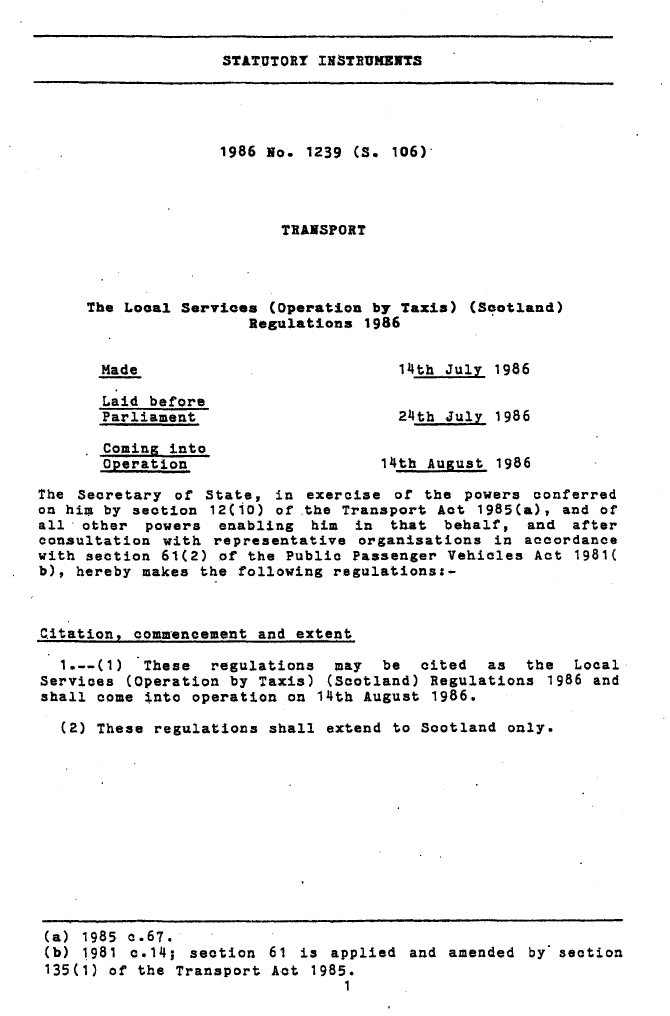
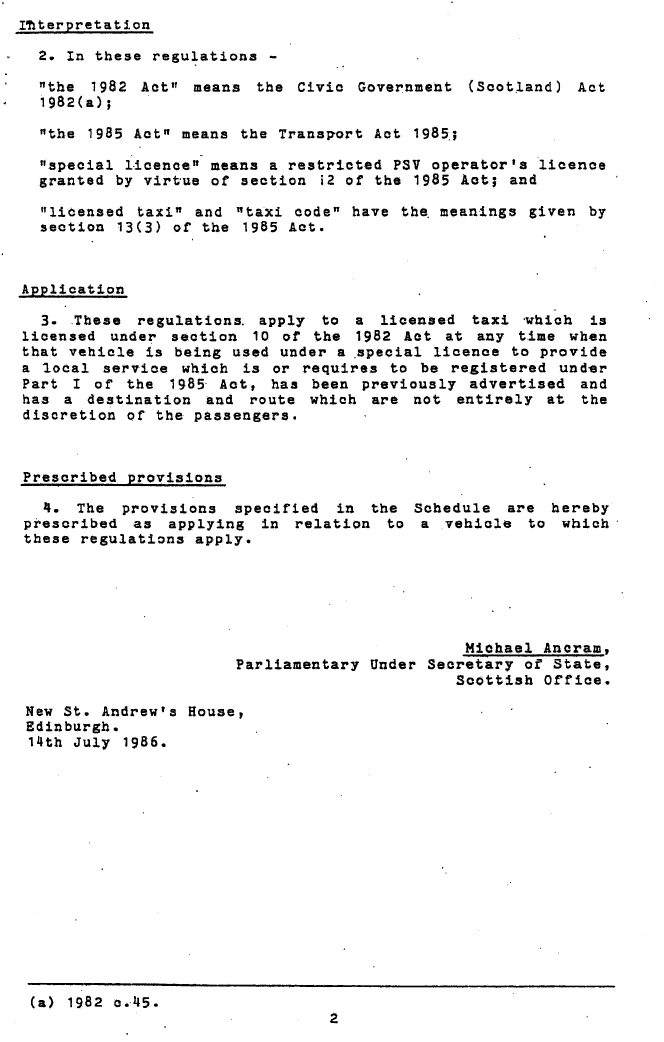
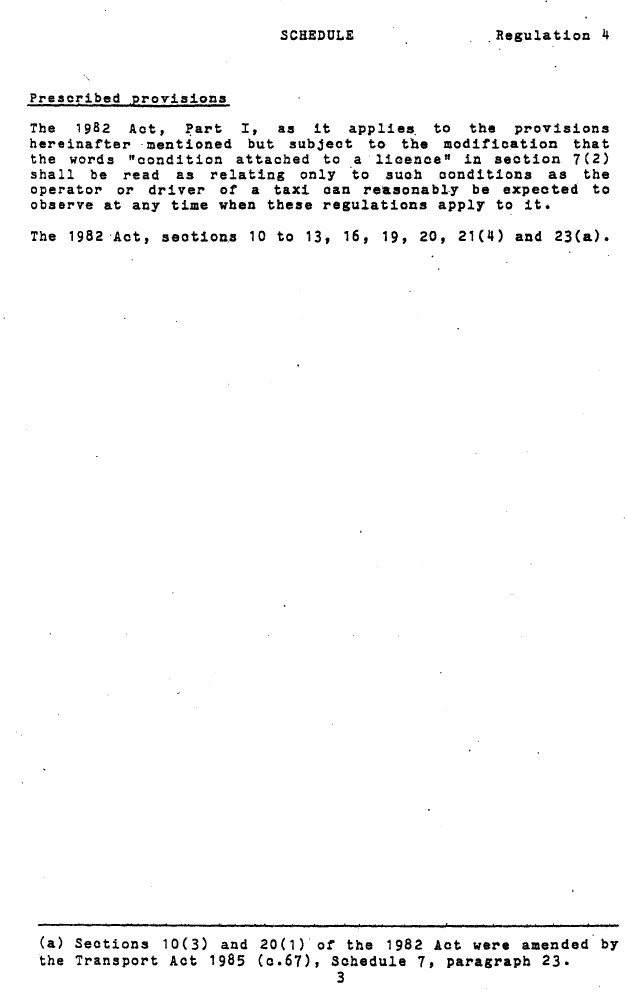
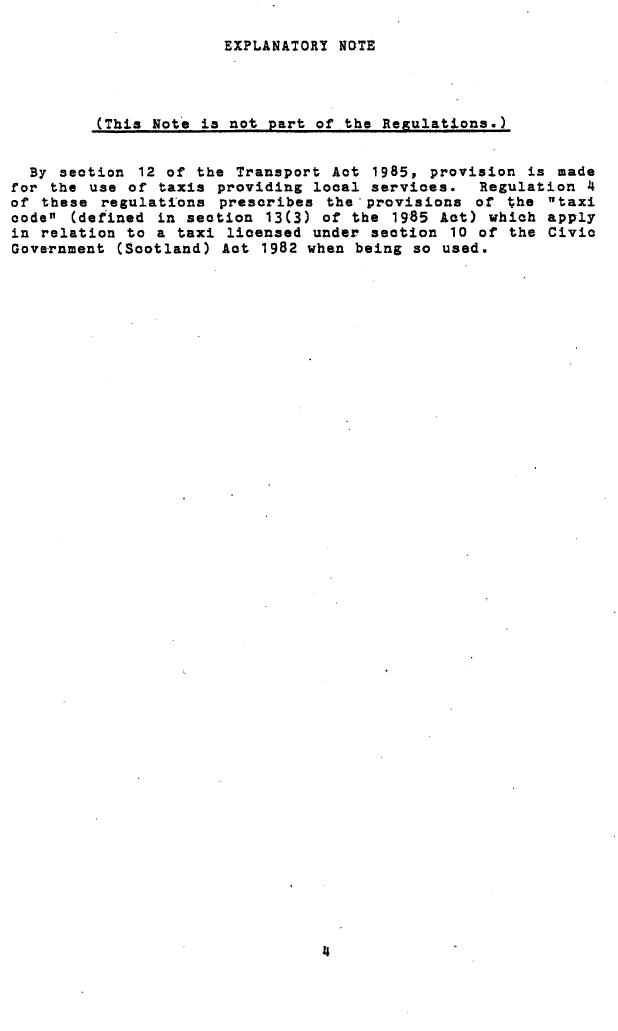
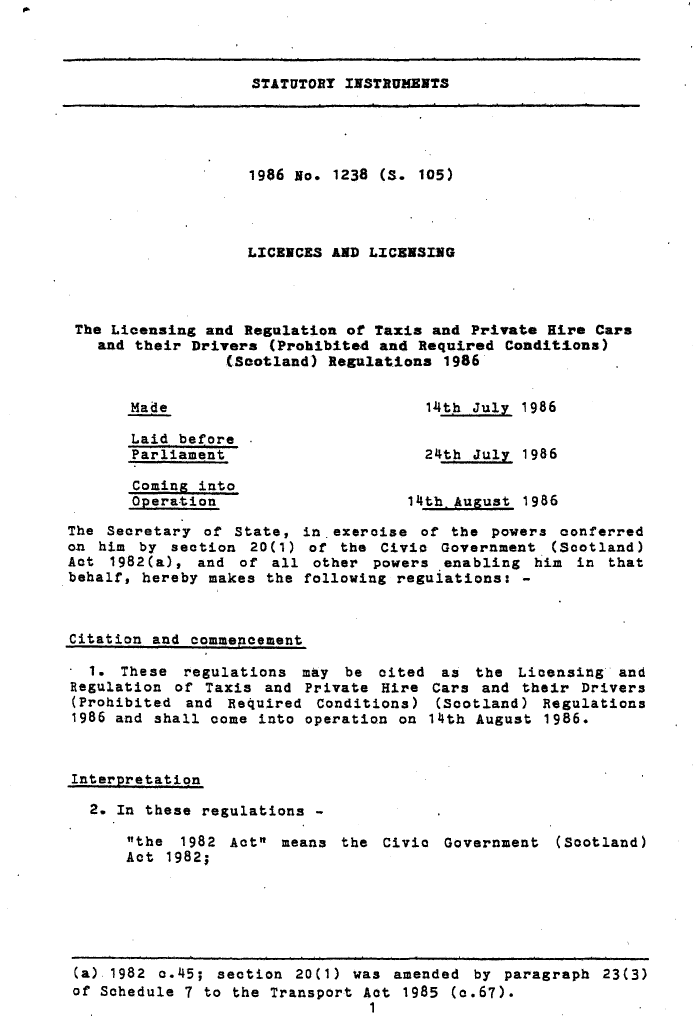
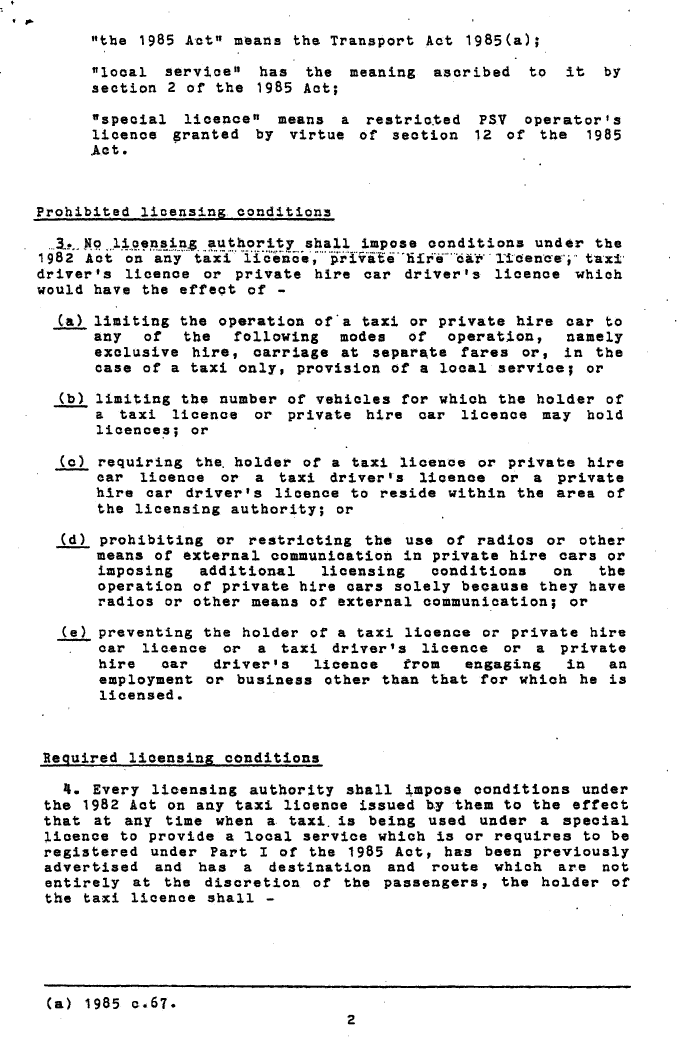
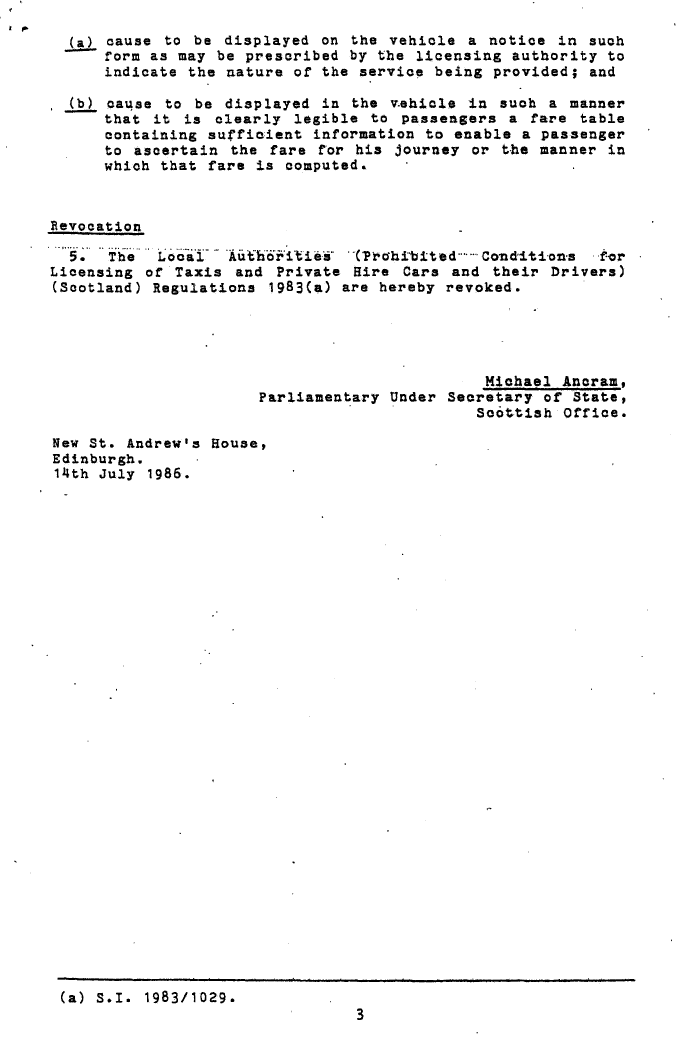
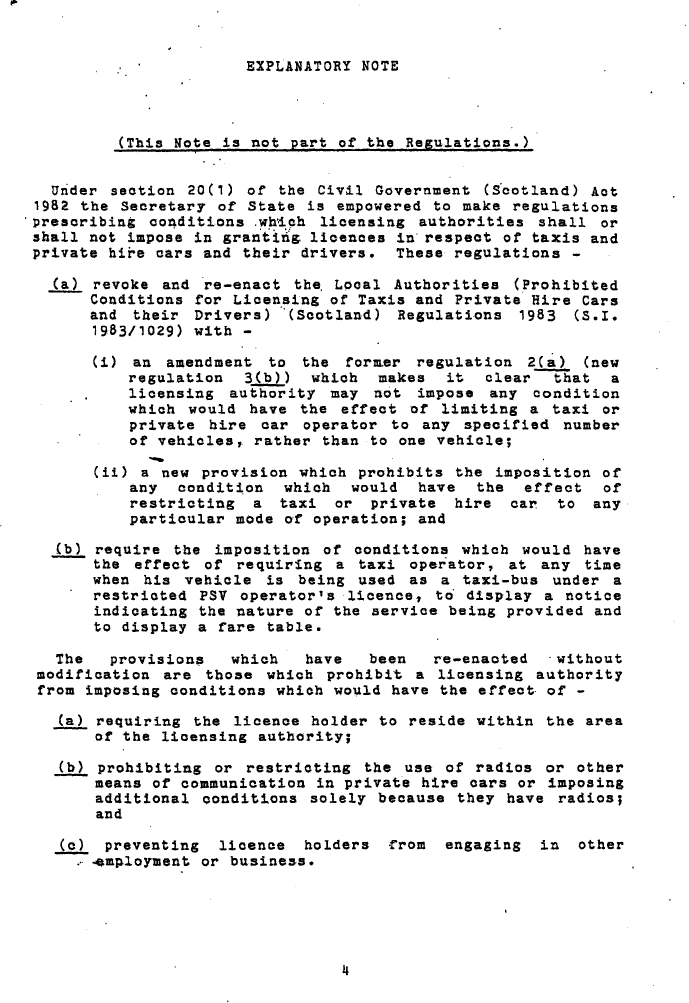
Contact
Email: Joanna Mackenzie
There is a problem
Thanks for your feedback